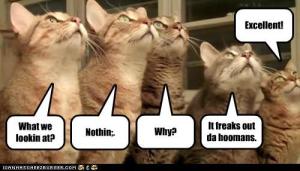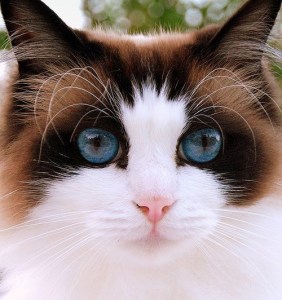One of the New Year's resolutions that people make, including me, is to get into better shape physically and lose some of those pounds we put on over the holidays. We need to think about our pets too, not only at this time of year, but all year long. My vet told me that neutered male cats have a real tendency to put on weight. Once that starts, it's hard to control. Had heard about food puzzles so decided to check it out. Here's what I found.
Cats love to play with toys and chase fake mice around the house and
this sometimes extends to their food. And when bored, our cats tend to
eat more especially when dry food is let out all day long. Food Puzzles
can help make cats work for their food while stimulating them at the
same time.
What are food puzzles?
Food puzzles are contraptions or home-made puzzles that make cats
work for their food. The puzzles can be as simple as putting dry food in
a closed and empty cottage cheese container and cutting a hole in the
side, so that the cat has to bat around the container to get the food to
fall out
Food Puzzles can help our cats from over-eating and behave better according to a new study
Cats given food puzzles thrive as they tend to be more physically fit
and happier. It seems there are also fewer behavioral problems, such as
aggression and over-grooming, than cats with regular food bowls.
“Food puzzles provide cats with exercise and mental stimulation,”
said review co-author Mikel Delgado, a doctoral candidate of psychology
at the University of California, Berkeley. Delgado is also a certified
cat behavior consultant with the International Association of Animal
Behavior Consultants. "It gives them an outlet to let cats be their
natural predatory selves."
Indoor cats tend to be overweight since they don’t have to work for food and get less exercise
Indoor kitties are often given unlimited food, and don’t have to work for their dinner. "It's no wonder that indoor felines have a high risk of obesity, Type 2
diabetes, joint problems and chronic lower urinary tract signs," she
said. Indoor cats can also have behavioral problems, including
attention-seeking and stress-related behaviors, such as house soiling.
In the review, cats that used food puzzles were thinner and behaved better
Food puzzles can alleviate those health and behavior problems. In the
review, Delgado and her colleagues assessed about 30 cases that they
had personally observed when food puzzles helped kitties. For instance,
an obese 8-year-old male cat lost 20 percent of its body weight after
using food puzzles for a year. Another case was a pair of sibling cats. They were constantly meowing for food, wanting the owner's attention and stealing leftover food from dirty plates on the counter. The owner stopped leaving out leftover food, and gave the cats food
puzzles, which slowed down both cats’ eating. Afterward, the cats
stopped meowing for food so much, and they left the owner alone while
they were distracted with the food puzzle.
Food puzzles have worked on kittens and even senior cats
Food puzzles have worked on kittens, senior cats, three-legged cats
and blind cats. Delgado did caution that young, old and
disabled cats should be given easy puzzles as a way to ensure that
they’re getting enough food. And, for the cats who love them, keep them
challenged by changing the puzzle.
I think I'd better get started on making some food puzzles! Found some directions for making five different ones which I will share with you next week.
Marion Lovato is the author of Sam, the Superkitty. Her book
describes an ordinary cat changing into a superhero to protect his
family from things that go bump in the night. Available on Amazon as a
paperback or Kindle edition.
http://www.amazon.com/gp/product/1604588667




















































